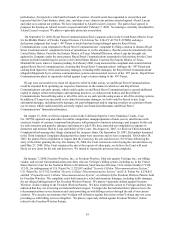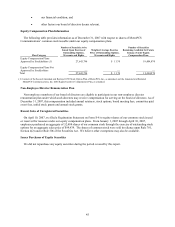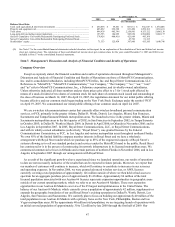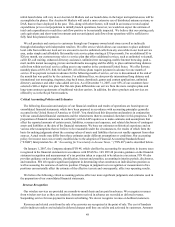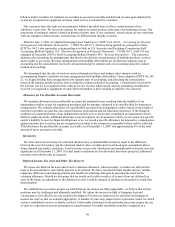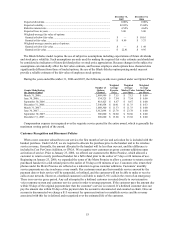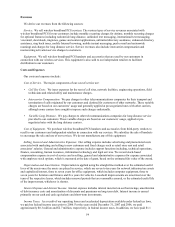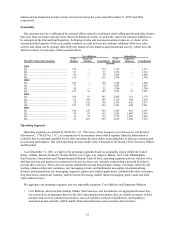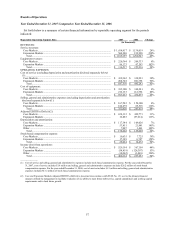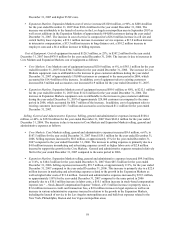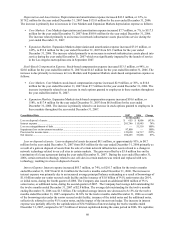Metro PCS 2007 Annual Report Download - page 63
Download and view the complete annual report
Please find page 63 of the 2007 Metro PCS annual report below. You can navigate through the pages in the report by either clicking on the pages listed below, or by using the keyword search tool below to find specific information within the annual report.52
Share-Based Payments
We account for share-based awards exchanged for employee services in accordance with SFAS No. 123(R),
“Share-Based Payment,” (“SFAS No. 123(R)”). Under SFAS No. 123(R), share-based compensation cost is
measured at the grant date, based on the estimated fair value of the award, and is recognized as expense over the
employee’ s requisite service period. We adopted SFAS No. 123(R) on January 1, 2006. Prior to 2006, we
recognized stock-based compensation expense for employee share-based awards based on their intrinsic value on the
date of grant pursuant to Accounting Principles Board (“APB”) Opinion No. 25, “Accounting for Stock Issued to
Employees,” (“APB No. 25”) and followed the disclosure requirements of SFAS No. 148, “Accounting for Stock-
Based Compensation — Transition and Disclosure,” (“SFAS No. 148”), which amends the disclosure requirements
of SFAS No. 123, “Accounting for Stock-Based Compensation,” (“SFAS No. 123”).
We adopted SFAS No. 123(R) using the modified prospective transition method. Under the modified prospective
transition method, prior periods are not revised for comparative purposes. The valuation provisions of
SFAS No. 123(R) apply to new awards and to awards that are outstanding on the effective date and subsequently
modified or cancelled. Compensation expense, net of estimated forfeitures, for awards outstanding at the effective
date is recognized over the remaining service period using the compensation cost calculated under SFAS No. 123 in
prior periods.
We have granted nonqualified stock options. Most of our stock option awards include a service condition that
relates only to vesting. The stock option awards generally vest in one to four years from the grant date.
Compensation expense is amortized on a straight-line basis over the requisite service period for the entire award,
which is generally the maximum vesting period of the award.
The determination of the fair value of stock options using an option-pricing model is affected by our common
stock valuation as well as assumptions regarding a number of complex and subjective variables. The methods used
to determine these variables are generally similar to the methods used prior to 2006 for purposes of our pro forma
information under SFAS No. 148. Prior to our initial public offering, factors that our Board of Directors considered
in determining the fair market value of our common stock, include the recommendation of our finance and planning
committee and of management based on certain data, including discounted cash flow analysis, comparable company
analysis and comparable transaction analysis, as well as contemporaneous valuation reports. After our initial public
offering, the Board of Directors uses the closing price of our common stock on the date of grant as the fair market
value for our common stock. The volatility assumption is based on a combination of the historical volatility of our
common stock and the volatilities of similar companies over a period of time equal to the expected term of the stock
options. The volatilities of similar companies are used in conjunction with our historical volatility because of the
lack of sufficient relevant history equal to the expected term. The expected term of employee stock options
represents the weighted-average period the stock options are expected to remain outstanding. The expected term
assumption is estimated based primarily on the stock options’ vesting terms and remaining contractual life and
employees’ expected exercise and post-vesting employment termination behavior. The risk-free interest rate
assumption is based upon observed interest rates on the grant date appropriate for the term of the employee stock
options. The dividend yield assumption is based on the expectation of no future dividend payouts by us.
As share-based compensation expense under SFAS No. 123(R) is based on awards ultimately expected to vest, it
is reduced for estimated forfeitures. SFAS No. 123(R) requires forfeitures to be estimated at the time of grant and
revised, if necessary, in subsequent periods if actual forfeitures differ from those estimates. We recorded stock-
based compensation expense of approximately $28.0 million and $14.5 million for the years ended December 31,
2007 and 2006, respectively.
The value of the options is determined by using a Black-Scholes pricing model that includes the following
variables: 1) exercise price of the instrument, 2) fair market value of the underlying stock on date of grant,
3) expected life, 4) estimated volatility and 5) the risk-free interest rate. We utilized the following weighted-average
assumptions in estimating the fair value of the options grants for the years ended December 31, 2007 and 2006:



